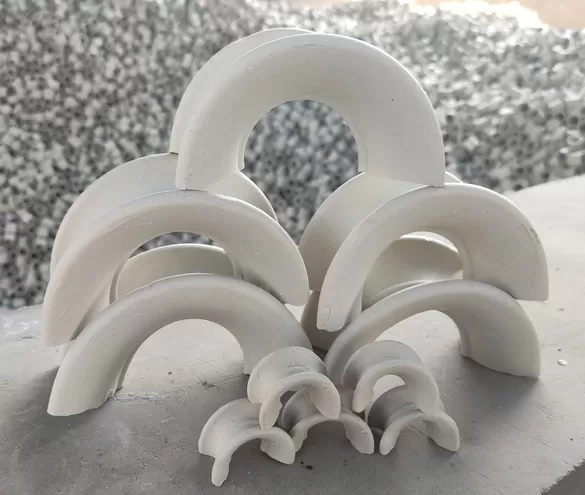Ceramic Intalox saddle packing, as a critical mass transfer component in industrial separation processes, must comply with strict technical standards to ensure performance stability and application safety. These standards cover material composition, geometric dimensions, mechanical properties, and testing methods, providing unified specifications for production, inspection, and application.

Material and Composition Standards
The primary material of ceramic Intalox saddles is alumina ceramic, with technical standards specifying alumina content ranges based on application grades. For general-purpose ceramic saddles, alumina content is typically required to be ≥75% to ensure basic mechanical strength and corrosion resistance; for high-performance variants used in harsh conditions (such as strong acid environments or high-temperature distillation), alumina content must reach ≥90%, with strict limits on impurity content (e.g., silica ≤5%, iron oxide ≤1%) to avoid affecting chemical stability. Standards also regulate raw material purity, requiring ceramic powders to undergo impurity removal processes to prevent defects like pores or cracks in the final product.
Geometric Dimension Specifications
Key geometric parameters are strictly defined to ensure consistent packing performance. The standards specify size tolerances for critical dimensions such as saddle height, width, and thickness—for example, the height deviation of 25mm ceramic saddles should not exceed ±0.5mm, and the thickness uniformity error must be ≤0.3mm. The curvature radius of the saddle surface and the angle of the arc transition are also standardized to optimize fluid flow paths, reducing resistance while ensuring sufficient contact area. Additionally, the number of saddles per unit volume (bulk density) is specified, usually ranging from 300 to 1500 pieces/m³ depending on size, to guarantee uniform packing density in columns.
Mechanical and Performance Requirements
Mechanical property standards focus on compressive strength, wear resistance, and thermal stability. The compressive strength of ceramic Intalox saddles should generally be ≥150 MPa (for 75% alumina grades) and ≥250 MPa (for 90% alumina grades) to withstand column packing pressure and operational loads. Wear resistance is evaluated through abrasion tests, requiring weight loss after a specified number of friction cycles to be ≤0.5% to avoid particle contamination in the process. Thermal shock resistance is critical for high-temperature applications—standards mandate that the packing remains intact after rapid temperature changes (e.g., from 200°C to 20°C in water) without cracks or fragmentation, ensuring stability in fluctuating temperature environments.
Testing and Quality Control Standards
Technical standards outline rigorous testing methods to verify compliance. Chemical composition analysis is conducted using X-ray fluorescence (XRF) or wet chemical analysis to confirm alumina and impurity content. Dimensional inspections are performed using precision calipers or optical measuring instruments, with sampling rates not less than 5% of each batch. Mechanical performance tests include compressive strength testing via universal testing machines and thermal shock testing through cyclic temperature exposure. For corrosion resistance, immersion tests in specified media (e.g., 10% sulfuric acid or sodium hydroxide solutions at 80°C for 100 hours) are required, with weight loss ≤1% to confirm suitability for corrosive workflows.
Application and Installation Guidelines
Technical standards also provide recommendations for application and installation to maximize performance. They specify suitable operating conditions, such as temperature ranges (-20°C to 1200°C depending on alumina grade) and pH limits (pH 1–13 for general grades, expanded to pH 0–14 for high-alumina grades). Installation guidelines emphasize uniform packing to avoid bridging or voids, suggesting layer-by-layer filling with vibration compaction for large-diameter columns. Standards also recommend regular inspection cycles based on service conditions, such as annual checks for wear or corrosion in high-load applications, to ensure long-term operational efficiency.

